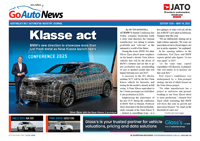Future models - Hyundai - AccentNew York show: Hyundai reveals its American AccentNo hatch: The Hyundai Accent sedan will be launched in Australia in the third quarter of this year, while the hatch variant (pictured left) is unlikely to come here. Oz-bound Hyundai Accent sedan makes US debut majoring on fuel economy, space2 May 2011 SOUTH Korean auto-maker Hyundai used the New York show to launch its new light-sized Accent hatch and sedan onto the US market ahead of its showroom arrival there in the Northern summer. In contrast to the car slated for Australian release in the third quarter of this year as a more upmarket sedan sibling to the Indian-built i20 hatch, the sedan variant of the US market Accent will be the entry-level model with 14-inch steel wheels, while the hatch – which isn’t coming here – will be more highly equipped. Air-conditioning, electric windows and cloth door inserts are part of an option package for the manual transmission sedan, although automatic models get these as standard. A premium package, which is only available with the automatic transmission, adds extra equipment, including keyless entry, steering wheel audio controls, cruise control, Bluetooth, 16-inch alloys and body-coloured door handles. Hyundai Australia will be pitching the Accent sedan as an upmarket alternative to the well-equipped i20 hatch, so expect locally-delivered cars to be highly specified.  From top: Hyundai i20, Hyundai Accent exterior and interior, Hyundai Elantra, Hyundai Veloster. From top: Hyundai i20, Hyundai Accent exterior and interior, Hyundai Elantra, Hyundai Veloster.Hyundai Motor America makes much of the Accent’s roominess. Despite its sub-compact (light car) exterior dimensions – at 4369mm in length the sedan is 69mm longer than the equivalent Yaris and 78m longer than the booted Fiesta – the Accent is classified as a compact (small) car in the US due to its interior volume. Hyundai claims its glovebox is at least 20 per cent bigger than the rival Chevrolet Aveo (Holden Barina), Toyota Yaris and Honda Fit (Jazz). Despite a 22 per cent stiffer body structure, extra safety features and on-board technology, Hyundai claims to have avoided weight gain with the new Accent, which in manual sedan form weighs 1087kg. It is claimed to be 18 per cent more fuel efficient than the outgoing model (11 per cent for the auto) thanks to a new 103kW/167Nm 1.6-litre direct injection petrol engine, which is 18kg lighter than the unit it replaces and has a claimed best-in-class specific output of 63kW per litre. The powerful engine and low weight of the new Accent give it a 22 per cent power-to-weight ratio advantage over the previously class-leading Honda Fit. The 1.6-litre engine in the i20 produces 12kW less power and 11Nm less torque than the Accent but must pull a car that is 32kg heavier. Hyundai estimates the Accent will achieve 5.9L/100km on the highway cycle and 7.8L/100km on the city cycle compared with Australian standard figures of 5.1L/100km and 7.7L/100km for the manual-equipped 1.6-litre i20 (5.4 and 8.4 for the auto). The i20 makes do with a four-speed automatic, which adversely affects fuel economy, while the Accent’s six-speed auto results in the same consumption as the manual. Hyundai’s ActiveECO function, available on cars fitted with the six-speed auto, finesses engine and transmission control to smooth throttle response and achieve a claimed seven per cent improvement in real-world fuel economy. Other major efficiency contributors are electric power steering, alternator management system, low rolling-resistance tyres, 0.30 drag coefficient and the new six-speed transmissions. Other new Hyundai models for Australia this year include the Elantra, a sedan counterpart for the successful i30 small hatch scheduled to arrive in Q3, the i40, an upmarket Euro-spec wagon to complement the i45 mid-size sedan around November, and the Veloster coupe near the end of the year. A turbocharged Veloster variant was expected to debut at New York but failed to materialise and Hyundai Motor Company Australia maintains that it has no information about such a vehicle. In the first quarter, Hyundai’s sales in Australia were down five per cent on last year to 20,143. The i30 is the brand’s sales leader with 6705 units sold, followed by 5086 for the Getz, which is in run-out and represents the last bastion of bargain-basement Hyundais as it will soon be discontinued.  Read more2nd of April 2011  Seoul show: Hyundai’s chic new fuel cell sedanSleek Seoul concept previews Hyundai fuel cell tech and all-new i40 sedan22nd of March 2011  Hyundai Getz optimistic about new modelsVolume-selling i10 now off Hyundai’s agenda as brand moves upmarket21st of March 2011  Hyundai Veloster caps 2011 model rolloutFour new Hyundai models by year’s end but still room for i40 sedanAccent pricingMotor industry news |
Click to shareHyundai modelsResearch Hyundai Accent pricingMotor industry news |
















Facebook Twitter Instagram